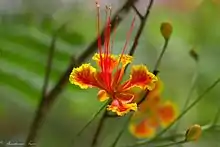Enslaved women's resistance in the United States and Caribbean
Enslaved women were expected to maintain the enslaved populations, which led women to rebel against this expectation via contraception and abortions. Infanticide was also committed as a means to protect children from either becoming enslaved or from returning to enslavement.
Physical and sexual exploitation
The ideologies surrounding the physical strength and fertility of African women was used to exploit African women throughout enslavement. While enslaved women were expected to perform manual labor equal to enslaved males, enslaved women were also expected to perform reproductive labor. For an enslaver, it was more profitable to produce his own enslaved population than it was to purchase enslaved peoples.[1] This desire for profits and increases in land size led to forced enslaved breeding, either with other enslaved males or enslavers. While some enslaved women were able to select their male partners, others were denied the freedom of choice and had a male partner forced onto them. Whether or not the male partner had been selected by the enslaved women, it was still expected of her to birth as many children as possible in order to increase profits for the enslaver.[1] Some enslavers also offered rewards for having additional children in order to encourage enslaved women to have children, enhancing the enslaver's profits.[1] In consequence, rebellion by enslaved women sometimes took the form of acting against these expectations.
Contraception

Contraception was an act of rebellion because it shifted the power and control from enslaver to the enslaved. Since enslaved women were expected to maintain the enslaved populations, enslaved women used various methods to undermine this expectation. Abortions and contraceptives were also seen as a means for enslaved women to exercise agency over their bodies by allowing the women to control their ability to be impregnated. The peacock flower and the cotton root were plants that could be used as abortifacients.[2] The use of cotton root was common, with other enslaved men worrying about their own population due to the high use of cotton root.[2] In Maria Merian's Metamorphosis of the Insects of Surinam, she recorded that indigenous women used the plant to induce abortions.[3][4] In the United States and Caribbean, both indigenous and enslaved women have used the peacock flower to abort pregnancies. By taking contraception and abortifacients, enslaved women were denying enslavers authority over their bodies; by not having children, enslaved women were limiting the profits enslavers could make off their bodies.[2]
Infanticide

Infanticide was an act of rebellion because it allowed enslaved women to prevent the enslavement of their children. Due to partus sequitur ventrum, the idea that a child inherits the status of its mother, any child born to an enslaved women would also become enslaved, as well as become part of the enslaver's property.[5] Because of this notion, some enslaved women were caught between wanting their children both alive and dead.[6][7] This led to some women committing infanticide to protect their children from impending enslavement. One of the more notable cases of infanticide is that of Margaret Garner. While fleeing north with her husband and their four children, the Garners were caught at one of the homes they were hiding in. Although Garner planned to kill her children and then herself, she managed to kill one of her daughters and injured the others when marshals stormed the house searching for the Garner family.[8] Garner was put on trial and indicted for property damage. Her remaining children, husband, and herself were returned to her enslaver's brother in Louisiana.[9]
Harriet Jacobs, a former enslaved woman who wrote about her experience, also had a traumatic motherhood experience. In her book, Incidents in the Life of a Slave Girl, Jacobs described how her owner threatened to take her children away from her if she didn't comply with his sexual advances.[10][11] In the late Toni Morrison's book Beloved, she mentions that one of the enslaved women viewed her child as the only untouched aspect of herself.[6] The child within her was not touched by enslavement and was the only clean aspect of her, so by committing infanticide, she was keeping that part of herself clean and untainted by enslavement.[6]
References
- Jennings, Thelma (1990). ""Us Colored Women Had to Go Though A Plenty": Sexual Exploitation of African-American Slave Women". Journal of Women's History. 1 (3): 45–74. doi:10.1353/jowh.2010.0050. ISSN 1527-2036.
- Perrin, Liese M. "Resisting Reproduction: Reconsidering Slave Contraception in the Old South." Journal of American Studies35, no. 2 (2001):255–74.
- Merian, Maria (1705). Metamorphosis of the Insects of Surinam.
- Schiebinger, Linda (2007). Plants And Empire: Colonial Bioprospecting In The Atlantic World. Harvard University Press. ISBN 978-0674025684.
- Morgan, Jennifer L. (2018-04-03). "Partus sequitur ventrem: Law, Race, and Reproduction in Colonial Slavery". Small Axe. 22 (1): 1–17. ISSN 1534-6714.
- Dukats, Mara L. 1993. "A Narrative of Violated Maternity: Moi, Tituba, Sorcière ... Noire De Salem." World Literature Today 67(4):745.
- Roth, Sarah N. "‘The Blade Was in My Own Breast’: Slave Infanticide in 1850s Fiction." American Nineteenth Century History8, no. 2 (2007):169-185. doi: 10.1080/14664650701387896
- Noble, Thomas. 1867. "The Story of Margaret Garner [Margaret Garner, a Slave Who Escaped from Kentucky to Ohio; Her 4 Children, 2 of Which She Killed so They Would Not Have to Endure Slavery, Lying Dead on Floor; and 4 Men Who Pursued Her]". Harper’s Weekly11:308.
- Carroll, Rebecca (2019-01-31). "Margaret Garner, a Runaway Slave Who Killed Her Own Daughter". The New York Times. ISSN 0362-4331. Retrieved 2019-12-02.
- Li, Stephanie. 2006. "Motherhood as Resistance in Harriet Jacobs Incidents in the Life of a Slave Girl." Legacy23(1):14–29.
- Jacobs, Harriet A. Incidents in the Life of a Slave Girl: Written by Herself. Boston, MA: Thayer & Eldridge, 1861.
